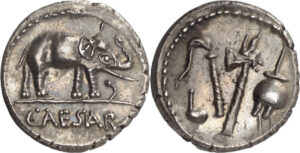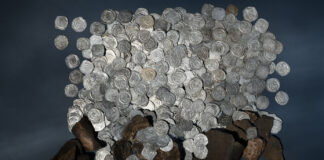The Top Results of Künker’s Auctions of Ancient Coins
A total of eleven special collections in five Künker catalogs, auctioned off on as many as seven days – that is too much material for a single review of Künker’s Spring Auction Sales. Therefore, we will split it up. This review presents the top five ancient coins from the Wolf Collection and the top five Republican denarii from the Fritzotto Bauss Collection.
The Wolf Collection
191 ancient coins, most of them gold issues and mainly from Roman times – that was the content of the Roger Wolf Collection. All pieces were characterized by above-average quality and a carefully documented pedigree, which can easily be checked because Künker also depicted the catalog of the auction in which the piece was first sold.
Here we present the five most expensive coins of the auction: four aurei and a Greek stater.

5th Place
In fifth place we have the extremely rare aureus for Didia Clara. The piece jumped from an estimate of 25,000 euros to a hammer price of 60,000 euros. It is not much that we know about the woman depicted on the issue. She was the only child known to us of the short-lived Emperor Didius Julianus and his wife Manila Scantilla, for whom the emperor also had coins minted. Didius Julianus is believed to have won the throne by the highest bid, as in an auction sale. Cassius Dio mentions 25,000 sesterces that Didius Julianus is said to have promised to each praetorian as a premium should he take office. His daughter’s hand might also be part of a deal, after all, she did marry the highly influential prefect of the city of Rome shortly after her father was proclaimed emperor. It is not known what happened to her after Didius Julianus was assassinated. She disappeared from history.

4th Place
Another ruler on whom the light of historiography only shone for a brief period was Sampsiceramus of Emesa, or Uranius Antoninus, as he was called after being proclaimed emperor. The priest was one of many local commanders who used the authority of the imperial office to better organize resistance against an external enemy. In the case of Uranius Antoninus, these enemies were the Sasanians under Shapur I. However, after Emperor Valerian had rushed to this front with the Roman army, nothing was ever heard again of Uranius Antoninus. Only the extremely rare coins he left us with tell of his ambitions. One of them is this aureus, celebrating the victoriousness of the emperor. The piece, whose first documented appearance in a collection dates to 1937, had an estimate of 40,000 euros and was sold at 70,000 euros.

3rd Place
Regarding the coins of the twelve Caesars, Otho is the most difficult emperor to get one’s hands on. Due to his carefully undulated hair, which – as Suetonius tells us – was a wig, his portrait seems reminiscent of that of Emperor Nero. And there was a good reason for it. Otho was one of his closest friends. He was part of a ménage à trois about which Roman sources gossiped on end. Of course, with the most scandalous result possible. Anyway, Otho owed the office of governor of Lusitania to the fact that he divorced his wife Poppaea so that Nero could marry her. This was to make him so powerful that he could afford to enter the battle for emperorship after Nero’s death.
The three months of his reign are attested to by very rare denarii and even rarer aurei, which always fetch high results, especially when they feature such a fine portrait as that on the piece offered by Künker. It was sold at 82,500 euros and had been estimated at 25,000 euros.

2nd Place
The second most expensive lot of the ancient coins from the Wolf Collection is the only Greek coin in our top five list. It is a late classical stater from Panticapaeum on the Crimean peninsula, which was already famous for its rich grain harvests in ancient times. Therefore, the citizens of Miletus had set up a colony there, which became rather prosperous, as is attested to by its wonderful gold coins.
They depict Pan on the obverse, whose name recalls the name of the city. On the reverse we can see a griffin, as it is often seen on Scythian depictions. In Greek mythology, this creature is considered the protector of the gold mines of the Arimaspi, which were described by Herodotus as a legendary people living in the north.
Gold staters from Panticapaeum are rare and always sought after due to their excellent engravings. Therefore, the price of this coin jumped from an estimate of 30,000 euros to 95,000 euros.

1st Place
The most expensive piece of the sale of ancient issues from the Wolf Collection was an aureus of Macrinus, whose provenance dates back to 1913. Aurei by Macrinus are very rare, especially in this quality. The piece, which still shows many traces of FDC-quality luster, above all on the reverse, jumped to almost twice its estimate of 60,000 euros to fetch 110,000 euros.
Macrinus was a high-ranking officer of Caracalla, who is said to have been involved in the assassination plot against him. He ruled little more than a year, from 11 April 217 until 8 June 218. This is the reason why his coins – especially his aurei – are comparatively rare. Perfect pieces such as this one combined with such an impressive provenance are sure to bring high results.
Fritzotto Bauss
The Fritzotto Bauss Collection proves that one does not have to be a millionaire to collect Roman coinage. The collection contained exceptionally well preserved denarii of the Roman Republic. Although the prices of such pieces did increase over the last years, except for a few specimens, they are still in the three-digit range – even regarding coins of very attractive quality. The pieces only get more expensive when they immortalize special motifs or can be associated with a famous name of Roman history.

5th Place
Therefore, the two coins in fifth place of the Bauss Collection are coins by Caesar. Both of them were sold at 2,200 euros – despite an admittedly low estimate of 300 euros.
The first specimen depicts an elephant on the obverse. It picks up a widely known Greek fable: The insidious serpent lunges at the mighty elephant from above, trying to gouge out its eyes. The elephant defends itself by trampling the snake – a perfect parable of how Caesar interpreted his role in the Roman civil wars.

5th Place
The second piece depicts a female head with oak wreath on the obverse, behind it the number LII, which scholars try to associate with Caesar’s age. On the reverse we can see a trophy made of Gallic weapons, which told every Roman user of this denarius why a man such as Caesar deserved to hold an outstanding office in Rome.
Although both denarii are not really rare, they are only seldomly found in such perfect quality and, especially, with such a fine patina, which explains the high price of the pieces.

4th Place
2,800 euros – that is what the collector had to bid who wanted to add the denarius by Sulla’s son from 56 BC to his collection. The depiction on the reverse is explained by Plutarch in his Vitae. He recounts that Sulla wore a signet ring that depicted the subjugation of the Numidian King Jugurtha.
We do know that followers of Roman politicians liked to publicly show their support by using the depiction of this politician’s signet ring themselves. So by recalling his father’s merits on this coin, Sulla’s son positioned himself as a candidate for a high political office. His opponents understood the message, too: Faustus Cornelius Sulla was captured and executed by a supporter of Caesar during the civil war.

3rd Place
Once again, a coin by Caesar ranks in our top five list. Regarding coins of the Roman Republic, the coins of this ruler almost always fetch the highest prices, especially when they depict a portrait of the dictator. Although the portrait on this piece is “only” very fine, with a punch blemishing his cheek, the coin jumped from an estimate of 1,000 euros to a hammer price of 3,600 euros.

2nd Place
Are early Roman coins actually “Roman” pieces? Or do they still follow the Greek tradition? When it comes to their prices, the latter might be true, because the first Roman didrachms with skillful depictions in the finest Greek style are sold at prices that can well keep up with classical coinage of Magna Graecia. This also holds true for the didrachm of the Fritzotto Bauss Collection. Its obverse depicts Heracles with lion skin and club, the reverse the Roman she-wolf suckling Romulus and Remus.

1st Place
And the most expensive coin of the collection? Another portrait of Caesar! This time of exceptionally great quality, although a weak strike slightly affects its perfection at the bottom of the obverse. At 4,600 euros, the coin realized an excellent price, more than twice its estimate of 2,000 euros.
It is remarkable that the most expensive specimen of a collection of coins of the Roman Republic, which was assembled over decades with much love and expertise, “only” fetches a result of 4,600 euros. It should be remembered that we obviously cannot enumerate all the pieces that were sold at prices in the lower three-digit range. And this perfectly illustrates that this is still a wonderful field for any collector.
You can find all results on the Künker website.




